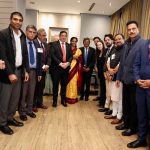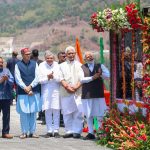 Kyoungsoo KIM is the archetypal gentleman diplomat. Suave, witty and extremely warm, the Consul General of the Republic of Korea in Chennai definitely checks all the boxes of an ideal ambassador. Not just politics and foreign affairs – Mr. Kim’s expertise extends to gastronomy as well, which includes the Tamilian palate. Barely a month into his job in the southern Indian city, he is as much at ease with his Sambhar as he is with his Sashimi. And Mr. Kim is not alone. There are around 3700-odd Korean expats who currently call Chennai home. And they were thrilled to see President Park Geun-hye in India mid-January, an important visit that has taken bilateral ties to new heights.
Kyoungsoo KIM is the archetypal gentleman diplomat. Suave, witty and extremely warm, the Consul General of the Republic of Korea in Chennai definitely checks all the boxes of an ideal ambassador. Not just politics and foreign affairs – Mr. Kim’s expertise extends to gastronomy as well, which includes the Tamilian palate. Barely a month into his job in the southern Indian city, he is as much at ease with his Sambhar as he is with his Sashimi. And Mr. Kim is not alone. There are around 3700-odd Korean expats who currently call Chennai home. And they were thrilled to see President Park Geun-hye in India mid-January, an important visit that has taken bilateral ties to new heights.
Chennai Calling
 The city saw its earliest Korean settlement in 1996 when auto-giant Hyundai decided to open its factories in India. With an initial investment of $600 million, the car major installed its first ever manufacturing unit in the country at Sri Perumbudur, located on the fringes of Chennai. Within a span of four years, the company exported its 100,000th car in Asia. The growth rate of the exports, however, did not quite match that of its nationals. By 2006, the city had only about 700 Koreans living in Chennai; most were Hyundai employees. The success story of the plant has inspired other Korean MNCs like Samsung, LG and Lotte to follow suit. Several smaller enterprises dealing in automotive parts such as Tsal, Mando, Woory, Dong-Sung and Doowon also sprang up to support these chaebols – Korean for conglomerates. Besides automotive parts, nearly 200 small and medium scale companies dealing in the Electricals, Electronics and Engineering (EEE) sector, IT, and pharmaceuticals have also set up base in Chennai. Examples include Shinhan Plasto India, SL Lumax, Asian PPG Industries and In-Ji Controls, among others.
The city saw its earliest Korean settlement in 1996 when auto-giant Hyundai decided to open its factories in India. With an initial investment of $600 million, the car major installed its first ever manufacturing unit in the country at Sri Perumbudur, located on the fringes of Chennai. Within a span of four years, the company exported its 100,000th car in Asia. The growth rate of the exports, however, did not quite match that of its nationals. By 2006, the city had only about 700 Koreans living in Chennai; most were Hyundai employees. The success story of the plant has inspired other Korean MNCs like Samsung, LG and Lotte to follow suit. Several smaller enterprises dealing in automotive parts such as Tsal, Mando, Woory, Dong-Sung and Doowon also sprang up to support these chaebols – Korean for conglomerates. Besides automotive parts, nearly 200 small and medium scale companies dealing in the Electricals, Electronics and Engineering (EEE) sector, IT, and pharmaceuticals have also set up base in Chennai. Examples include Shinhan Plasto India, SL Lumax, Asian PPG Industries and In-Ji Controls, among others.
Winning it with Wons
Thanks to the influx of Korean companies in the city, Chennai today houses more than 3000 people in its townships at Kilpauk and Alwarpet. This has earned the city the sobriquet of ‘Little  Korea. Mid- and high-level management professionals, engineers, scientists, research scholars, students, musicians and artists make up the Korean community here, which is a testimony to ever-increasing bilateral trade ties. The recent ‘Time Series of Bilateral Trade between Korea and India’ released by South Korea’s Ministry of Foreign Affairs illustrates the exponential rise in trade between the two countries from a mere USD 15 million in 1973 – when the two countries formally established their diplomatic ties – to USD 11,224 million in 2007. And in January 2011, a year after India and RoK upgraded their relationship to a ‘strategic partnership’ and the Comprehensive Economic Partnership Agreement (CEPA) came into effect, total trade volume between the two countries reached a whopping USD 20,548 million! While the overall global downturn did bring down the trade volume to about USD 18, 843 million in 2012, both countries remain optimistic about expanding bilateral trade to USD 40 billion by 2015.
Korea. Mid- and high-level management professionals, engineers, scientists, research scholars, students, musicians and artists make up the Korean community here, which is a testimony to ever-increasing bilateral trade ties. The recent ‘Time Series of Bilateral Trade between Korea and India’ released by South Korea’s Ministry of Foreign Affairs illustrates the exponential rise in trade between the two countries from a mere USD 15 million in 1973 – when the two countries formally established their diplomatic ties – to USD 11,224 million in 2007. And in January 2011, a year after India and RoK upgraded their relationship to a ‘strategic partnership’ and the Comprehensive Economic Partnership Agreement (CEPA) came into effect, total trade volume between the two countries reached a whopping USD 20,548 million! While the overall global downturn did bring down the trade volume to about USD 18, 843 million in 2012, both countries remain optimistic about expanding bilateral trade to USD 40 billion by 2015.
What prompts this optimism? Mr. Kim stresses that India, and Chennai especially, present an untapped reservoir of abundant natural resources and the Koreans have just the right technological expertise to exploit these. This mutually beneficial partnership will thus continue. Korean investments in the Indian market will allow the latter to utilise its resources economically and efficiently, while creating more jobs. In fact, there is a dawning realisation amongst different South Korean stake-holders that expanding relations with India should be a major economical and political priority for the country.
Spurred by a significant convergence of interests, mutual goodwill and high level exchanges, India-RoK relations have made great strides in recent years to become truly multidimensional.
Kimchi amidst Kara Kuzhambu
With trade comes culture. This includes, first and foremost, gastronomic and culinary exchanges. The big Korean community therefore has made its presence felt in the kitchens of Chennai. Today there are four restaurants in the city that offer authentic Korean cuisine. In Seoul and Deok Su Gung serve Chennaiites with Korean Kimchi, while Koreans savour dishes like Kara Kuzhambu, Vattal, Dosas and Sambhar at joints like Saravana Bhavan, Murugan Idli Kadai, Kumarakom. A food connoisseur, Mr. Kim is emphatic that Chennai offers some of the best fish in the Indian subcontinent.
Apart from gastronomy, Koreans in Chennai are also spurring other cultural exchanges. The InKo centre headquartered in Chennai aims to promote inter-cultural dialogue by facilitating a consistent programme that draws on the two countries’ rich traditions. By offering a varied range of classes from the Korean language to taekwondo and others, Chennai is calling out to Koreans and Indians to move beyond commerce. And thankfully, language is no barrier, since most Chennaiites are fluent in English as are Koreans. Mr Kim jokes that he had a harder time communicating in Beijing, courtesy his poor Mandarin, than in Chennai. With its warm, friendly and intelligent people, Chennai can only symbolise a bright future for India-RoK ties, notes the Korean ambassador. Truly a generous serving of sambhar for the s(e)oul!
Author Profile
- India Writes Network (www.indiawrites.org) is an emerging think tank and a media-publishing company focused on international affairs & the India Story. Centre for Global India Insights is the research arm of India Writes Network. To subscribe to India and the World, write to editor@indiawrites.org. A venture of TGII Media Private Limited, a leading media, publishing and consultancy company, IWN has carved a niche for balanced and exhaustive reporting and analysis of international affairs. Eminent personalities, politicians, diplomats, authors, strategy gurus and news-makers have contributed to India Writes Network, as also “India and the World,” a magazine focused on global affairs.
Latest entries
 DiplomacyOctober 4, 2025UNGA Resolution 2758 Must Not Be Distorted, One-China Principle Brooks No Challenge
DiplomacyOctober 4, 2025UNGA Resolution 2758 Must Not Be Distorted, One-China Principle Brooks No Challenge India and the WorldJuly 26, 2025MPs, diplomats laud Operation Sindoor, call for national unity to combat Pakistan-sponsored terror
India and the WorldJuly 26, 2025MPs, diplomats laud Operation Sindoor, call for national unity to combat Pakistan-sponsored terror India and the WorldJuly 25, 2025When Fire Ends, Diplomacy Begins
India and the WorldJuly 25, 2025When Fire Ends, Diplomacy Begins India and the WorldJuly 16, 2025Operation Sindoor and its Aftermath: India’s Successful Diplomatic Outreach
India and the WorldJuly 16, 2025Operation Sindoor and its Aftermath: India’s Successful Diplomatic Outreach







